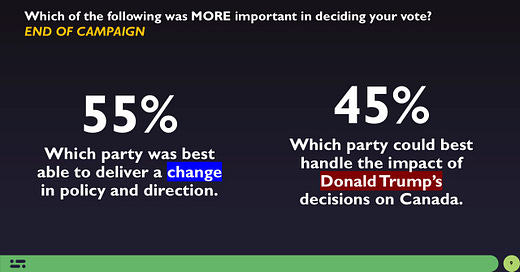One Election, Two Questions: How Leadership and Trust Defined Canada's 2025 Federal Election
A summary of my talk at the Empire Club post-election event in Toronto last night
Last night, I had the privilege of addressing the Empire Club in Toronto to offer my reflections on Canada's 2025 federal election. My central theme was simple —this was one election defined by two distinct ballot questions, fundamentally rooted in valence politics.
Valence politics might sound complex, but at its core, it's about evaluating leaders based on their perceived ability to deliver outcomes on widely agreed-upon goals. This election wasn't really about stark ideological divides although partisanship played a big factor; Canadians broadly shared priorities like safeguarding national sovereignty, restoring affordability, and improving healthcare. Instead, what deeply divided voters was their assessment of leadership capability—specifically, which leader, Mark Carney or Pierre Poilievre, could best deliver on these objectives.
Early in the campaign, our Abacus Data polling revealed voters were nearly evenly split between two primary concerns: 54% prioritized managing the external threat posed by Donald Trump’s aggressive stance towards Canada, while 46% prioritized significant domestic policy change, especially related to affordability, housing, and crime.
Over the campaign period, this dynamic subtly shifted. Our final polling indicated a reversal, with 55% of voters ultimately prioritizing domestic policy changes and economic revitalization, while 45% continued to emphasize the external threat from Trump. This subtle yet significant shift underscored an increasing anxiety among voters about domestic stagnation, economic hardship, and institutional inefficiencies.
Demographic patterns reinforced this duality.





